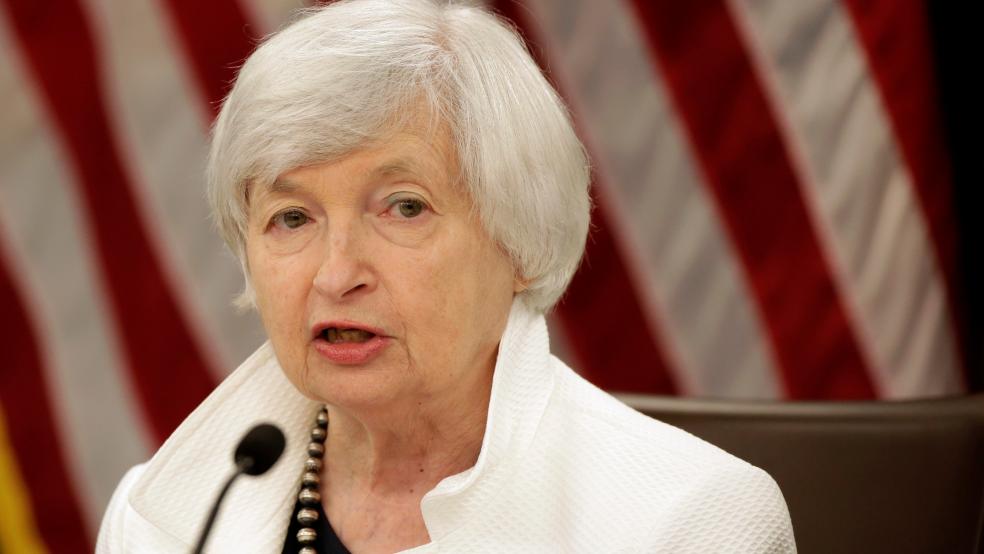For the first time since the financial crisis, the Federal Reserve's luxury of time is running out.
For years, a weak jobs market, tepid demand and low inflation allowed the Fed to drag its feet on ending its long experiment with ultra-easy monetary policy. That's changing now, and it's going to considerably increase the difficulty of setting policy through the rest of 2016 and into 2017.
Adding to the pressure: The stakes could hardly be higher, with just 1-in-3 Americans satisfied with the state of the country, 58 percent saying that economic conditions are getting worse and heightened political divisions resulting in violent protests and fire bombings. But a Fed decision to continue to wait could unearth a terrible threat: Stagflation, the combination of economic stagnation and high inflation.
Related: 7 Big Risks That Could Derail the Stock Market’s Rally
As things stand now, the futures market has priced in a near 70 percent chance the Fed raises rates before the end of the year. While an increase from 0.5 percent to 0.75 percent may not seem like a big deal, it's coming at a time of extreme sensitivity to changes in long-term interest rates.
Thanks to the OPEC-driven rebound in crude oil prices, inflation expectations have been drifting higher in recent weeks. This — combined with efforts by the Bank of Japan to lift long-term rates (to ease the burden on savers, banks and corporate pensions plans) and rumors concerning the European Central Bank (that it could soon taper its bond buying program) — has pushed the U.S. 10-year Treasury yield from a low of 1.37 percent in July to a high of 1.80 percent on Friday.
That doesn't seem like much of a change, but in percentage terms it's huge: A one-third increase in yield. Yield-sensitive assets like utility, telecom and real estate stocks have been absolutely hammered: The Utilities SPDR (XLU) lost nearly 9 percent from late September to early October, nearly three years' worth of dividend payments.
Related: As the Recovery Falls Short, the Fed Eyes a 'High Pressure' Economy
Higher interest rates would also hit stocks by draining the intense buying support that's come from debt-funded corporate buyback and dividend programs. No wonder market breadth has been cratering, with just 32 percent of NYSE stocks in uptrends vs. 83 percent back in July.

Moreover, the inflation pressure is set to rise, due in part to "base effects": 2015’s oil price decline makes today’s prices look inflated by comparison. Bank of America Merrill Lynch estimates that, if OPEC continues its talk of a possible supply freeze, higher gas prices could push the inflation rate toward 4 percent by the end of the year. The base effect will continue to boost inflation through next February.
Related: What’s Ailing the Economy? Political Paralysis May Be the Biggest Problem
Yet even as inflation heats up, and the financial markets reveal just how sensitive they are to rate hikes and higher yields, the economy is hitting serious headwinds.

The Atlanta Fed's GDPNow real-time estimate of third-quarter growth has fallen to just 1.9 percent, down from 3.8 percent in August. This follows actual annualized growth of just 1.1 percent over the first half of the year. Combined with the New York Fed's 1.6 percent estimate for fourth-quarter growth, and the economy is set to expand by just 1.4 percent in 2016.
Want more evidence all's not well?
How about the fact U.S. retail sales are growing at the weakest clip since last November as demand for the new iPhone 7 has fallen flat? Or that, according to Bank of America Merrill Lynch’s internal debt and credit card data, spending continues to decline in six core areas: Restaurants and bars, hotels and airlines, furniture and home improvement, teen retailers, grocery stores and luxury retailers. Or that industrial production just fell for its 13th straight month, marking the longest non-recessionary streak in U.S. history?
While no one knows what the Fed will do at its December policy meeting, the realities on the ground suggest no matter the decision, it's going to be painful. A rate hike would worsen an already frail economy and stock market while waiting would further boost oil-driven inflation and erode consumer confidence.






